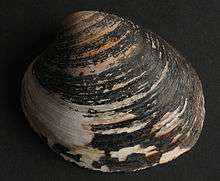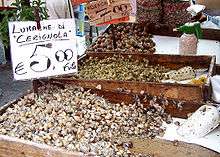Arctica islandica
The ocean quahog (Arctica islandica) is a species of edible clam, a marine bivalve mollusk in the family Arcticidae. This species is native to the North Atlantic Ocean, and it is harvested commercially as a food source. This species is also known by a number of different common names, including Icelandic cyprine,[1] mahogany clam, mahogany quahog, black quahog, and black clam.[2]
| Ocean quahog | |
|---|---|
 | |
| A shell of Arctica islandica with the valves separated | |
| Scientific classification | |
| Kingdom: | Animalia |
| Phylum: | Mollusca |
| Class: | Bivalvia |
| Subclass: | Heterodonta |
| Order: | Venerida |
| Superfamily: | Arcticoidea |
| Family: | Arcticidae |
| Genus: | Arctica |
| Species: | A. islandica |
| Binomial name | |
| Arctica islandica Linnaeus, 1767 | |
The typical Arctica islandica resembles the quahog, but the shell of the ocean quahog is rounder, the periostracum is usually black, and on the interior of the shell, the pallial line has no indentation, or sinus. Unlike the quahog, which lives intertidally and can be collected by clam digging, this species lives subtidally, and can only be collected by dredging. They grow to sizes exceeding 50 mm or two inches shell height.[3] An individual specimen was reported to have lived 507 years, making it the longest-lived non-colonial metazoan whose age was accurately known.[4]
Life cycle and longevity
Arctica Islandica shows slower growth rate than other species of clams, it takes an average rate of 4-days for birth (embryo to larvae stage). Furthermore it takes an average of 5.8-years for the A. Islandica to reach maturity, at this point the somatic costs start going down. Dynamic Energy Models (DEM) predict that Arctica islandica's extreme longevity arises from a lowered somatic maintenance costs and a low aging acceleration.[5] For individuals in populations in cold areas the growth rate is probably further slowed because growth only occurs in summer.[6] This slow life style results in exceptional longevity with a highest reported age, for Ming the clam, of 507 years. This makes it the longest living non-colonial metazoan species with an authenticated lifespan. [4][7][8] It is unknown how long it could have lived if it had not been collected alive by an expedition in 2006. In 1868 one specimen, collected alive near Iceland, was 374 years old. The study of its growth rate and the oxygen isotope data showed that it had a highly variable growth at the peak of the Little Ice Age around 1550–1620 and mild climate near its end around 1765–1780 and had recorded the volcanic eruption of Mount Tambora in 1815.[9] One study found that in animals aged 4–192 years, antioxidant enzymes declined rapidly in the first 25 years, which includes the growth and sexual maturity stages, but afterwards remained stable for over 150 years. Though more detailed studies are warranted, it appears this species is a case of negligible senescence.[10] In contrast to the exceptionally long-lived populations in relatively deep, cold parts of its range, more southern populations that experience greater seasonal variations in salinity and temperature are typically far shorter-lived. For example, A. islandica from the German Bay of Kiel typically only reach an age of about 30 years and those from the German Bight about 150.[11]
Feeding ecology
Like other clam species, Arctica islandica is a filter feeder. Feeding activity appears regulated by light levels, which can be used as a proxy for food availability. This means that at the northern extreme of the distribution, feeding is concentrated during eight months of the year, while during the rest of the year the clams only feed for a few days a month.[6]
See also
- List of long-living organisms
- Maximum life span
- Ming (clam)
| Wikimedia Commons has media related to Arctica islandica. |
Notes
- Sabatini, M. & Pizzola, P.F., 2007. Arctica islandica. Icelandic cyprine. Marine Life Information Network: Biology and Sensitivity Key Information Sub-programme [on-line]. Plymouth: Marine Biological Association of the United Kingdom. [cited 14 September 2007]. Available from: <http://www.marlin.ac.uk/species/Arcticaislandica.htm>
- Hackney, Cameron R.; Thomas E. Rippen (2000). "The Molluscan Shellfish Industry". In Roy E. Martin; Emily Paine Carter Jr.; George J. Flick; Lynn M. Davis (eds.). Marine and Freshwater Products Handbook. CRC Press. pp. 323–324. ISBN 1-56676-889-6.
- R. Witbaard; M.J.N. Bergman (2003). "The distribution and population structure of the bivalve Arctica islandica L. in the North Sea: what possible factors are involved?" (PDF). Journal of Sea Research. 50 (1): 11–25. Bibcode:2003JSR....50...11W. doi:10.1016/s1385-1101(03)00039-x. Archived from the original (PDF) on 2011-09-28.
- Butler, P.; Wanamaker, A. Jr.; Scourse, J.; Richardson, C.; Reynolds, D. (2013). "Variability of marine climate on the North Icelandic Shelf in a 1357-year proxy archive based on growth increments in the bivalve Arctica islandica". Palaeogeography,Palaeoclimatology, Palaeoecology. 373: 141–51. doi:10.1016/j.palaeo.2012.01.016.
- Ballesta-Artero, Irene; Augustine, Starrlight; Witbaard, Rob; Carroll, Michael L.; Mette, Madelyn J.; Wanamaker Alan, D.; Van Der Meer, Jaap (January 2019). "Energetics of the extremely long-living bivalve Arctica islandica based on a Dynamic Energy Budget model" (PDF). Journal of Sea Research. 143: 173–182. Bibcode:2019JSR...143..173B. doi:10.1016/j.seares.2018.09.016.
- Ballesta-Artero, Irene; Witbaard, Rob; Carroll, Michael L.; van der Meer, Jaap (2017). "Environmental factors regulating gaping activity of the bivalve Arctica islandica in Northern Norway". Marine Biology. 164 (5). doi:10.1007/s00227-017-3144-7.
- Butler, P.G. (2012). "Clam shells, climate change and ageing: The mollusc that had 500 birthdays" (PDF). Catalyst Secondary School Review. 23 (1): 6–8.
- Bulter, P.; et al. (2012). "Characterising the microstructure of Arctica islandica shells using NanoSIMS and EBSD" (PDF). Geochemistry, Geophysics, Geosystems. 13 (4): Q04002. Bibcode:2012GGG....13.4002K. doi:10.1029/2011GC003961.
- Schone, B.R.; et al. (2005). "Climate records from a bivalved Methuselah (Arctica islandica, Mollusca; Iceland)". Palaeogeography, Palaeoclimatology, Palaeoecology. 228 (1–2): 130–148. Bibcode:2005PPP...228..130S. doi:10.1016/j.palaeo.2005.03.049.
- "Ocean quahog clam (Arctica islandica) longevity, ageing, and life history".
- Strahl, Julia (2011). Life strategies in the long-lived bivalve Arctica islandica on a latitudinal climate gradient – Environmental constraints and evolutionary adaptations. Alfred Wegener Institute, Helmholtz Centre for Polar and Marine Research, University of Bremen.
External links
- Ocean quahog, Arctica islandica, Life history and habitat from the NOAA.
- Climate records from a bivalved Methuselah
| Wikimedia Commons has media related to Arctica islandica. |

